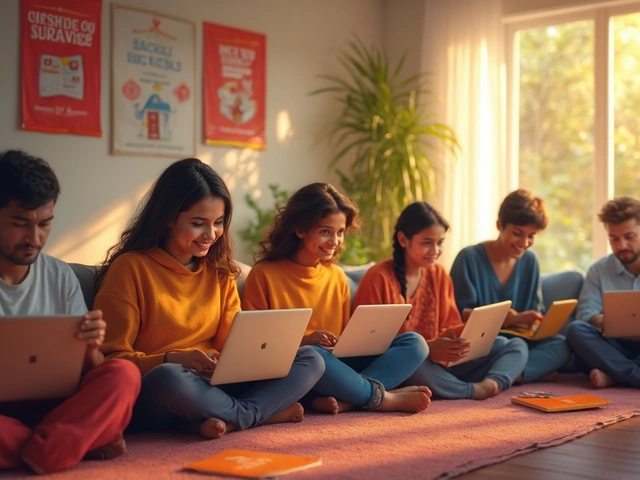
Best YouTube Channel for Spoken English: Nailing Real-Life Conversations
Scrolling through YouTube searching for spoken English lessons? You're definitely not alone. With so many channels promising to boost your speaking skills, it gets overwhelming fast. The thing is, not all channels are worth your time. Some dump endless grammar rules that never actually help you in real-life chats. Others have lessons that feel way too robotic or out of touch.
Here’s one simple truth: If you want to speak English naturally, you need channels that focus on everyday conversations. That means real phrases, expressions people actually use, and chances to hear different accents—not just textbook drills. Look for videos where English is spoken at a normal pace and there’s lots of focus on pronunciation. If you spot channels with short, practical lessons and tons of speaking practice, put those on your shortlist first.
- Why Spoken English on YouTube Works
- What Makes a Great Spoken English Channel?
- Top Channel Pick: The Real Standout
- Tips to Get the Most from YouTube Learning
- Common Pitfalls and How to Dodge Them
Why Spoken English on YouTube Works
YouTube isn’t just for cat videos. It’s actually one of the most popular places for people to learn spoken English. If you’ve ever wondered why, think about this: YouTube lets you watch real conversations, repeat them, and rewind as many times as you need. That’s something you just can’t do in a traditional classroom.
Here’s what really makes it work:
- Real voices with real accents. You get a taste of different regions and ways people speak, from American to British to Australian—and even non-native English speakers. This helps you understand and speak with all sorts of folks.
- Learning at your own pace. Never got that phrase the first time? Just hit replay. You won’t get weird looks for asking to repeat.
- Wide range of topics and situations. Whether it’s ordering at a restaurant, asking for directions, or job interview tips, channels have you covered with examples that actually show up in real life.
- Comments and community. You’re not learning alone. On tons of channels, viewers share extra tips, answer questions, and practice together. If you’re stuck, someone else probably had the same question.
YouTube really stands apart for English speaking because of simple accessibility. Anyone with a phone or laptop and an internet connection can access thousands of lessons, totally free. In fact, a 2024 survey by Statista found that over 60% of people learning a language online use YouTube as their primary resource. That’s a bigger share than any language-learning app.
Another cool thing? You don’t just hear a teacher’s voice. You watch real people talk, which means you can copy their mannerisms, facial expressions, and natural pauses—little things that make your English sound more legit.
The key: the best YouTube channel for learn English gives you all the stuff you truly need—clear explanations, real speech, and tons of chances to practice. That’s what sets YouTube apart if you’re serious about speaking like a native.
What Makes a Great Spoken English Channel?
If you toss "spoken English" into YouTube, you’ll see thousands of channels. But honestly, only a handful stand out when it comes to actually helping people speak confidently. Here’s what you should keep an eye out for if you want to make real progress with your English speaking.
- Native and Clear Speakers: The best spoken English channels feature native speakers or advanced speakers who speak clearly. You want to hear how real people actually talk—not actors reading a script or someone reading out grammar notes.
- Real Conversations: Lessons should revolve around actual conversations, not just isolated words or grammar points. If the channel uses street interviews, role plays, or dialogue-based lessons, that’s usually a big green flag.
- Easy-to-Follow Explanations: Complex grammar is useless if it’s not explained simply. Good channels break down common mistakes, pronunciation issues, slang, and tone in plain language. If you find yourself understanding without rewinding a ton, you’re onto something good.
- Focus on Pronunciation: Look for lessons that teach how to pronounce words naturally, not overly formal. Channels like ‘Rachel’s English’ and ‘English with Lucy’ spend extra time here, which helps you sound less robotic.
- Active Practice: Channels that get you to speak or repeat after the teacher help the most. Some even provide speaking challenges or conversation prompts in the comments—you want that.
- Up-to-Date and Consistent: Check how often the channel updates. If the last lesson was two years ago, skip it. English evolves fast, so fresh content matters.
Fun fact—according to YouTube’s survey from 2024, channels that use subtitles and break down real-life dialogues see about 60% more watch time than those that just focus on grammar rules. People stick around for the stuff that actually helps in real situations.
Shortlist channels that mix these qualities. If the channel just dumps long lectures or rarely lets you hear real conversations, you’ll probably end up bored or frustrated. The best ones help you imagine yourself chatting in a coffee shop, not sitting a test.

Top Channel Pick: The Real Standout
It’s not even close—English with Lucy is crushing it when it comes to learning spoken English on YouTube. With nearly 15 million subscribers in 2025 and a library that’s loaded with detailed, down-to-earth lessons, this channel takes the lead for practical, real-world English speaking.
Lucy Earl, the creator, is British, but she mixes lots of global English accents and gives tips to sound more natural, whether you’re aiming for British, American, or something in between. Her channel isn’t just about repeating phrases. She breaks down why people say things a certain way, common mistakes, and even how to sound more confident when talking with others.
One cool thing about English with Lucy is how interactive her lessons are. Viewers get exercises right in the videos—think pauses for you to try out phrases, mini pronunciation drills, even real conversation examples. Plus, there are lively comments sections where people share their own tips or questions, so you’re not learning alone.
Not convinced yet? Check out some of her most popular formats:
- Real-life dialogues – Watch and listen to daily life conversations, not just textbook stuff.
- Accent training – Get step-by-step guides on clear pronunciation for both British and American English.
- Word and phrase breakdowns – Learn why certain expressions work in real talk, and which ones sound awkward or outdated.
- Confidence-building tips – Simple tricks to help you stop overthinking and actually speak.
Here’s a quick look at some channel stats as of April 2025:
| Channel | Subscribers | Videos | Average Views per Video |
|---|---|---|---|
| English with Lucy | 14.8M | 430 | 1.2M |
With so many resources aimed at spoken English, you won’t waste time on boring grammar drills. Most viewers say their speaking confidence shoots up fast because of the friendly teaching style. If you want lessons that actually stick, this is the channel you’ll keep coming back to.
Tips to Get the Most from YouTube Learning
Just watching spoken English videos isn’t enough—you’ve got to know how to make them actually work for you. Here’s the thing: Learning English this way can save you money and give you access to native speakers and accents from around the world. But only if you’re active about it.
- Don’t just listen—talk back. Pause the video and repeat what you hear. Try to match the accent, speed, and even the emotion of the speaker. It’s awkward at first, but it makes a huge difference.
- Use subtitles smartly. First, watch with English subtitles so you catch every word. Then rewatch the video without them to check how much you really get. Some studies show learners remember 30% more vocabulary like this compared to just listening.
- Practice speaking out loud every day. Even if it’s just for a few minutes, daily speaking builds confidence way faster than silent studying. Make it a routine—brushing your teeth and repeating lines from your favorite YouTube video to yourself actually works.
- Keep a notebook for new words and phrases. Ignore boring vocabulary lists—write down only the stuff you hear all the time in videos. Review this mini-dictionary before you sleep or right before you watch another video.
- Join the comments or community. Lots of YouTube channel hosts answer questions directly in the comments. Sometimes they even take requests for video topics. Jumping in and asking questions is free practice and boosts your motivation.
Some of the most successful English learners on YouTube combine their video time with real talking practice. If you can, use apps like Tandem or HelloTalk to chat with someone after watching a video. It’s all about putting your new skills to the test as soon as possible.
| Study Habit | Average Retention Rate |
|---|---|
| Watching only | 10% |
| Watching + Speaking Aloud | 45% |
| Watching + Speaking + Using in Real Chat | 65% |
Get interactive and your progress will jump. Remember, YouTube is packed with tools, but you’ve got to use them actively to really improve your English speaking skills fast.

Common Pitfalls and How to Dodge Them
Learning spoken English on YouTube? There are plenty of slips that can slow you down, so let’s talk about what trips people up and how to dodge those traps.
First mistake: thinking more videos equals faster progress. Lots of learners binge dozens of channels, hoping to get fluent overnight. Instead, you end up confused by different styles, and it’s easy to mix up pronunciation or grammar. If you stick to one or two solid channels, you’ll get consistent, clear teaching. Quality always beats quantity here.
Another pitfall is only watching but never speaking out loud. YouTube is passive if you let it be. Your mouth needs the workout—repeat what you hear, even if you feel silly! A study from the British Council showed that learners who actively speak along with videos improve their fluency almost 40% faster compared to just listening. So, don’t be shy—talk right back at the screen.
Folks also get hung up on strong accents. Sure, understanding every accent is a challenge. But if a channel uses only one really slow, clear accent, you might struggle with real people later. Balance it out—pick channels with different native speakers, and variety becomes your strength.
Don’t ignore the comment section, either. It’s full of language exchange offers, corrections, and practice partners. Engaging with others makes learning way less lonely and multiplies your practice chances.
- Choose consistent, practical channels over bouncing between dozens.
- Always speak along, don't just passively watch.
- Expose yourself to different voices and accents, not just one slow talker.
- Use the comment section to practice, ask questions, and connect.
If you want a quick pulse on common mistakes and what helps, check this out:
| Common Pitfall | How to Dodge It |
|---|---|
| Binge-watching videos passively | Pause, repeat out loud, and mimic speakers |
| Relying on just one simple accent | Mix in channels with various speakers |
| Ignoring interactive features | Join comments, challenges, or quizzes |
Remember, the real win comes from mixing what you see with real-life action. Turn those videos into practice, not just background noise, and your English speaking will level up way faster.






Write a comment